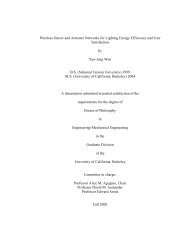Diagnostic Information Fusion for Manufacturing Processes
Diagnostic Information Fusion for Manufacturing Processes
Diagnostic Information Fusion for Manufacturing Processes
Create successful ePaper yourself
Turn your PDF publications into a flip-book with our unique Google optimized e-Paper software.
the system disagrees on the classification. Thus, the<br />
crosses are an indication of the area(s) in which the<br />
system has difficulty in deciding on a class. Fig. 7<br />
shows that NNBR has classification errors only near<br />
the cross-over points of the membership functions.<br />
These are areas where classification errors are<br />
expected, because a small change in the membership<br />
value results in an incorrect classification. Even at<br />
these points, however, NNBR membership values are<br />
very close to the true membership values. The success<br />
of this system is due to the continuous nature of the<br />
wear measure, and the averaging technique used in<br />
the nearest neighbor classification. The other systems<br />
are not as successful, and the membership values<br />
output do not approximate the true values to the<br />
degree that NNBR does.<br />
The high success rate of one tool means that if it were<br />
used as part of the majority fusion, the per<strong>for</strong>mance<br />
degrades somewhat. This is to be expected, because<br />
the votes of the poor per<strong>for</strong>mers will sometimes out<br />
vote the correct one. The problem is greater with<br />
increasing number of classification regions, as there<br />
will be cases when each system will generate a<br />
different class, and the majority voting system will<br />
then pick one randomly.<br />
Results<br />
The fusion using assignment of confidence values<br />
provides a means to integrate a priori in<strong>for</strong>mation<br />
about individual tool per<strong>for</strong>mance. This is<br />
accomplished by designing the validation curves of a<br />
better tool wider than the curves of the tools with<br />
worse per<strong>for</strong>mance. The fused per<strong>for</strong>mance improves<br />
the already very good per<strong>for</strong>mance of the NNBR tool<br />
from 96.8% to 99.1% correct classification with<br />
α=0.1 and m=0.1. Fig. 11 shows the result of the<br />
fused system where the membership functions no<br />
wear, little wear, medium wear, and high wear were<br />
estimated.<br />
Fig. 11: Fused system output<br />
Summary and Final Remarks<br />
The use of the FUDVAF algorithm provides a means<br />
to improve per<strong>for</strong>mance of individual diagnostic<br />
tools. In experiments with data from a milling<br />
machine, we show how the FUDVAF can be used <strong>for</strong><br />
extant systems. Much of per<strong>for</strong>mance improvement<br />
appears to be due to the smoothing and an increase of<br />
per<strong>for</strong>mance might also be expected when the<br />
smoothing is applied to the best tool alone.<br />
Future research should address how to improve fine<br />
tuning of the validation curve parameters, depending<br />
on operating conditions and sensor history. This can<br />
be accomplished through machine learning<br />
techniques similar to the approach used <strong>for</strong> the<br />
FUSVAF algorithm [11]. Also helpful might be<br />
knowledge about locally changing diagnostic tool<br />
per<strong>for</strong>mance. Such local characteristics could be<br />
utilized in designing the validation curves in a<br />
dynamic manner by changing the width accordingly.<br />
Generally, it is desirable to maintain maximum<br />
independence of the diagnostic tools in the sense that<br />
tools which exhibit poor per<strong>for</strong>mance in certain<br />
operating conditions are matched with tools<br />
exhibiting better conditions there. This may, of<br />
course, not always be possible due to the limitations<br />
of observable conditions and shortcomings of the<br />
diagnostic tools because often times (and in this<br />
approach here), all sensor values are made available<br />
to all diagnostic tools.<br />
Acknowledgements
















